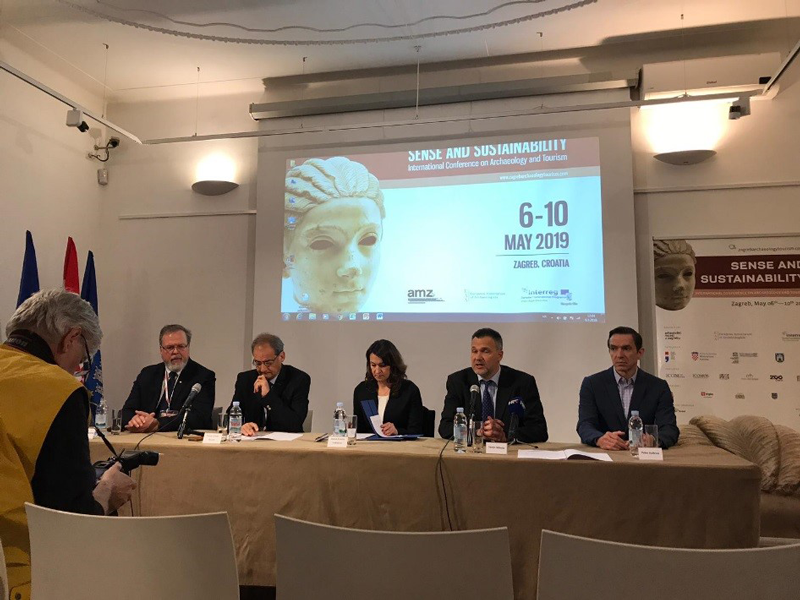by Margaret Gowen Larsen (treasurer@e-a-a.org), Treasurer EAA, Co-chair EAA Community on Integrating Archaeological Heritage Management and Tourism.
It was my great honour to represent the EAA Community on Integrating Archaeological Heritage Management and Tourism at this conference. It was the ‘brainchild’ of Sanjin Mihelić, Director of the Archaeological Museum in Zagreb, a member of EAA and ICOMOS International Committee Cultural Tourism (ICTC) and most importantly, an active member of our EAA Community.
Sanjin recognized the need for such a conference some two years previously and saw the potential for holding such a conference in Zagreb in 2019. The date coincided with the completion of a very important EU Interreg-funded archaeological project “Monumentalized Early Iron Age landscapes in the Danube river basin” (acronym “Iron Age Danube” project, with 10 project partners and 8 associated partners in 5 countries). Several of the archaeological cultural landscapes that were the focus of research are now the focus of sustainable tourism development projects. Several of these were featured as case studies in the conference sessions.
Through our EAA Community, EAA was exceptionally privileged to be invited to become a full partner in the conference. Annemarie Willems, the other Co- Chair of our EAA community, must be credited with the conference name – after much discussion during our EAA Community session in Barcelona last year.
EAA went on to be actively involved in the organization of the conference, defining its themes and working as part of its scientific committee. The conference created an exceptional opportunity for EAA and our EAA Community. Led by our President, Felipe Criado Boado, it was used to very good effect by those that were fortunate enough to attend. There was much to learn.
The conference presented a rare opportunity to hear about the working frameworks and perspectives of other disciplines and organizations, and to review a wide range of inspiring and challenging case studies. In as much that our EAA Community seeks, above all else, to facilitate and develop a helpful dialogue between all sectors working in heritage tourism, this meeting between archaeologists and tourism specialists helped us to work towards defining our commonalities. We can continue with confidence in our mission to achieve a common understanding and discourse between disciplines working in archaeological heritage tourism and in promoting a common vocabulary for that discourse. We must (of course) continue to advocate strongly for the conservation and management of archaeological heritage in cultural tourism policy, decision making and management.
The conference presented a wonderful opportunity to meet with and discuss this very topic in some depth with three important guests of the conference, namely:
- Peter De Brine (Director of the UNESCO World Heritage Sustainable Tourism Programme;
- Fergus Maclaren, President of the ICOMOS International Scientific Committee on Cultural Tourism, ICTC) and
- Manos Vougioukas, Secretary General of the European Cultural Tourism Network (ECTN) an organization that a very active member of the European Heritage Alliance 3.3.
In addition, there was time to speak with Sue Millar President Emeritus, ICTC and a very wide range of other delegates, while the programme included a number of very important presentations from the tourism and tourism economics perspective. The programme presented a ‘melting pot’ of interrelated topics linking archaeological research, archaeological heritage management, cultural tourism, World Heritage management, and sustainable development over three lengthy days of sessions. There were four themes:
- Heritage in Tourism Destination Management;
- Sustainable development, archaeology and tourism
- Tourism and Archaeological heritage management in Protected Areas, World Heritage Sites and National Parks; and
- Cultural Routes
Using a ‘mini’ EAA Annual Meeting approach to the conference organization, the three days of sessions were wide ranging and presented a combination of ‘the wisdom of experience’ in research and management contexts including the research undertaken, issues for management, individual case studies, and thematic topics. Overall, the common thread that tied the entire conference together was the challenge of achieving sustainable development outcomes for archaeological monuments, sites, and landscapes (urban and rural) that become tourist destinations. Case studies presented many instances where sustainability is seriously challenged and case studies on how ‘overtourism’ and visitation was being tackled.
Underlying all of these themes were the currents of the particular values of our various disciplines. We can say with confidence that many of these are mutual values.
Some innovative approaches were presented, that illustrated that an ‘adaptive reuse’ approach to historic monuments and archaeological heritage destinations can be successfully used in the context of cultural tourism uses. Nevertheless, there were also concerns and an examination of how we struggle to apply our archaeological values to the heritage management towns and cities when these become the focus of mass tourism exploitation; many are already experiencing significant problems.
The conference was focused on seeking ways to integrate the principles of sustainability to all perspectives and experience. Community members attending gained a wide range of insight; we have much to learn!
The UNESCO World Heritage Sustainable Tourism policies, resource library and especially its Toolkit/s, presented by Peter De Brine, are especially worthy of review by our community members (http://whc.unesco.org/sustainabletourismtoolkit/resources; https://whc.unesco.org/archive/2012/whc12-36com-5E-en.pdf) as is the Destination Management approach and the link to the Sustainable Development Goals SDGs, advocated by the ICOMOS ICTC, presented by Fergus Maclaren , while the tourism industry perspective from the European Network on Cultural Tourism (ECTN) presented by Manos Vougioukas, its charter, awards and successes are also noteworthy. Mechanisms for binding cultural together and creating opportunities for sustainable tourism were also presented. The Council of Europe Cultural Routes programme was presented and were a number of case studies.

Left: Margaret Gowen Larsen, EAA Treasurer, Co-chair EAA Community on Integrating Archaeological Heritage Management and Tourism, presenting at Sense and Sensibility (photo by Felipe Criado-Boado). Right: Felipe Criado-Boado, EAA President, at Sense and Sensibility, Zagreb 2019 (photo by Margaret Gowen Larsen).

Panel discussion, Sense and Sustainability: International Conference on Archaeology and Tourism, Zagreb, 6-10 May 2019 (photo by Margaret Gowen Larsen).
Go back to top